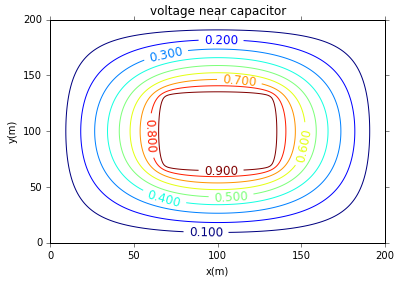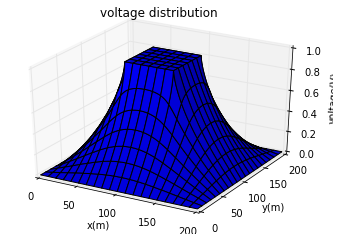@zy-0815
2016-12-11T17:25:59.000000Z
字数 4314
阅读 1579
计算物理第十二次作业Problem5.1
摘要
在前面的课程中我们已经学习了微分方程的求解方式,而这一节我们将通过Gauss-Sideal Method来求解拉普拉斯方程。
背景介绍
已知电场的Laplace's equation为:
微分可得:
由5.1可知,Gauss-Sideal Method有:
正文
关于电势的程序为:
from __future__ import divisionimport matplotlibimport numpy as npimport matplotlib.cm as cmimport matplotlib.mlab as mlabimport matplotlib.pyplot as pltfrom mpl_toolkits.mplot3d import Axes3D# initialize the gridgrid = []for i in range(201):row_i = []for j in range(201):if i == 0 or i == 200 or j == 0 or j == 200:voltage = 0elif 70<=i<=130 and j == 70:voltage = 1elif 70<=i<=130 and j == 130:voltage = 1elif 70<=j<=130 and i == 70:voltage = 1elif 70<=j<=130 and i == 130:voltage = 1else:voltage = 0row_i.append(voltage)grid.append(row_i)# define the update_V function (Gauss-Seidel method)def update_V(grid):delta_V = 0for i in range(201):for j in range(201):if i == 0 or i == 200 or j == 0 or j == 200:passelif 70<=i<=130 and j == 70:passelif 70<=i<=130 and j == 130:passelif 70<=j<=130 and i == 70:passelif 70<=j<=130 and i == 130:passelse:voltage_new = (grid[i+1][j]+grid[i-1][j]+grid[i][j+1]+grid[i][j-1])/4voltage_old = grid[i][j]delta_V += abs(voltage_new - voltage_old)grid[i][j] = voltage_newreturn grid, delta_V# define the Laplace_calculate functiondef Laplace_calculate(grid):epsilon = 10**(-5)*200**2grid_init = griddelta_V = 0N_iter = 0while delta_V >= epsilon or N_iter <= 10:grid_impr, delta_V = update_V(grid_init)grid_new, delta_V = update_V(grid_impr)grid_init = grid_newN_iter += 1return grid_newmatplotlib.rcParams['xtick.direction'] = 'out'matplotlib.rcParams['ytick.direction'] = 'out'x = np.linspace(0,200,201)y = np.linspace(0,200,201)X, Y = np.meshgrid(x, y)Z = Laplace_calculate(grid)plt.figure()CS = plt.contour(X,Y,Z,10)plt.clabel(CS, inline=1, fontsize=12)plt.title('voltage near capacitor')plt.xlabel('x(m)')plt.ylabel('y(m)')fig = plt.figure()ax = fig.add_subplot(111, projection='3d')ax.plot_surface(X, Y, Z)ax.set_xlabel('x(m)')ax.set_ylabel('y(m)')ax.set_zlabel('voltage(V)')ax.set_title('voltage distribution')plt.show()
运行结果为:


关于电场的程序为:
from __future__ import divisionimport matplotlibimport numpy as npimport matplotlib.cm as cmimport matplotlib.mlab as mlabimport matplotlib.pyplot as pltfrom mpl_toolkits.mplot3d import Axes3Dfrom copy import deepcopy# initialize the gridgrid = []for i in range(201):row_i = []for j in range(201):if i == 0 or i == 200 or j == 0 or j == 200:voltage = 0elif 70<=i<=130 and j == 70:voltage = 1elif 70<=i<=130 and j == 130:voltage = 1elif 70<=j<=130 and i == 70:voltage = 1elif 70<=j<=130 and i == 130:voltage = 1else:voltage = 0row_i.append(voltage)grid.append(row_i)# define the update_V function (Gauss-Seidel method)def update_V(grid):delta_V = 0for i in range(201):for j in range(201):if i == 0 or i == 200 or j == 0 or j == 200:passelif 70<=i<=130 and j == 70:passelif 70<=i<=130 and j == 130:passelif 70<=j<=130 and i == 70:passelif 70<=j<=130 and i == 130:passelse:voltage_new = (grid[i+1][j]+grid[i-1][j]+grid[i][j+1]+grid[i][j-1])/4voltage_old = grid[i][j]delta_V += abs(voltage_new - voltage_old)grid[i][j] = voltage_newreturn grid, delta_V# define the Laplace_calculate functiondef Laplace_calculate(grid):epsilon = 10**(-5)*200**2grid_init = griddelta_V = 0N_iter = 0while delta_V >= epsilon or N_iter <= 10:grid_impr, delta_V = update_V(grid_init)grid_new, delta_V = update_V(grid_impr)grid_init = grid_newN_iter += 1return grid_newx = np.linspace(0,200,201)y = np.linspace(0,200,201)X, Y = np.meshgrid(x, y)Z = Laplace_calculate(grid)Ex = deepcopy(Z)Ey = deepcopy(Z)E = deepcopy(Z)for i in range(201):for j in range(201):if i == 0 or i == 200 or j == 0 or j == 200:Ex[i][j] = 0Ey[i][j] = 0else:Ex_value = -(Z[i+1][j] - Z[i][j])/2Ey_value = -(Z[i][j+1] - Z[i][j])/2Ex[i][j] = Ex_valueEy[i][j] = Ey_valuefor i in range(201):for j in range(201):E_value = np.sqrt(Ex[i][j]**2 + Ey[i][j]**2)E[i][j] = E_valuefig0, ax0 = plt.subplots()strm = ax0.streamplot(X, Y, np.array(Ey), np.array(Ex), color=np.array(E), linewidth=2, cmap=plt.cm.autumn)fig0.colorbar(strm.lines)ax0.set_xlabel('x(m)')ax0.set_ylabel('y(m)')ax0.set_title('Electric field')plt.show()
运行结果为:

结论
对于prism geometry,势能和电场便如程序运行结果所示。
致谢
感谢贺一珺同学的程序。
